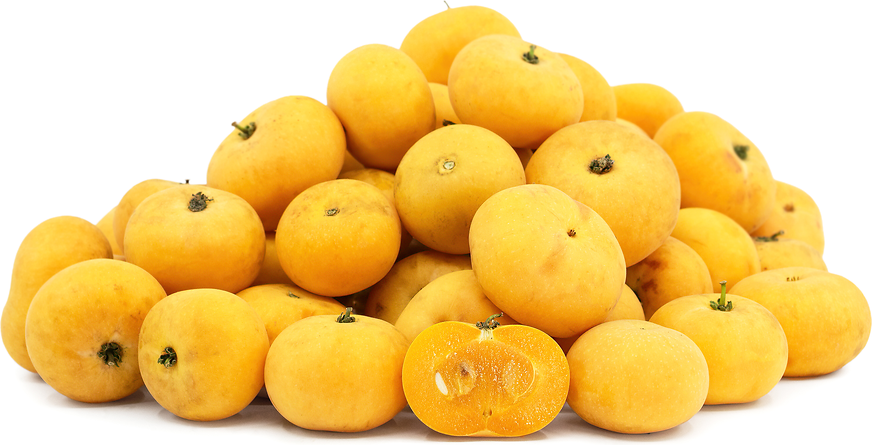


Kei Apples
Estimated Inventory, lb : 3.31
This item was last sold on : 01/02/25
Description/Taste
Kei apples are small fruits, averaging 2 to 5 centimeters in diameter, and have a round to oblate, curved shape. The skin is smooth, velvety, and semi-tough, ripening from green to yellow-orange with maturity. Underneath the surface, the golden flesh is soft, aqueous, succulent, and tender with an aromatic, sweet scent. In the center of the flesh, there may also be two rings of oval seeds, and each fruit contains 5 to 15 seeds. Kei apples vary in flavor from extremely acidic to sweet-tart with tangy, fruity notes reminiscent of mango, starfruit, and apricot.
Seasons/Availability
Kei apples are available in the late summer through fall. In some subtropical climates, the fruits are harvested year-round.
Current Facts
Kei apples, botanically classified as Dovyalis caffra, are small, tangy fruits found on an evergreen tree or shrub belonging to the Flacourtiaceae family. The rare fruits are considered berries and are native to Southern Africa, where they have been primarily gathered from plants used for natural fencing. Kei apples are named after the Kei River in the Eastern Cape province of South Africa. Outside of Africa, Kei apples have been introduced to subtropical climates around the world, where they have been grown as a coastal hedge. Kei apples are not commercially cultivated and are primarily grown in home gardens and small farms. The fruit’s fresh eating ability is highly variable, and due to its unpalatable acidic flavor, Kei apples are primarily reserved for cooked applications with added sweeteners. Despite their sour reputation, Kei apples are being selectively bred on a small scale in California by specialty growers to improve the fruit's flavors, creating more palatable, sweeter crops for fresh eating.
Nutritional Value
Kei apples are an excellent source of vitamin C, an antioxidant that reduces inflammation and strengthens the immune system, and are a good source of potassium, a mineral that balances fluid levels within the body. The fruits also contain antioxidants to protect the body against external environmental aggressors.
Applications
Kei apples are best suited for cooked applications and are frequently combined with sweeter fruits or sugar to develop a palatable flavor. The fruits can be eaten raw, but depending on how the fruits were bred, the flavor may vary from acidic and sharp to pleasant with a sweet-tart flavor. When acidic, the fruits can be sliced, sprinkled with sugar, and left to absorb the sugar before consumption. Once sweetened, the fruits can be eaten as a snack, dessert, or blended into a sweet beverage. Sugared Kei apple slices can also be used in fruit or green salads or incorporated into desserts such as cakes, puddings, tarts, and pies. The natural acidity and pectin content of Kei apples make them ideal for use in making jams, jellies, compotes, and syrups. Beyond jams, Kei apples can be simmered into sauces for meats, boiled and strained into a juice, used to flavor boiled grains, or dried into fruit leather. It is not recommended to cook Kei apples for extended periods as the fruits break down into a thick liquid when heated. Kei apples pair well with meats such a poultry, beef, and pork, fish, ginger, nutmeg, cinnamon, fruits such as strawberries, peaches, coconuts, and apples, vanilla, and caramel. Whole Kei apples should be immediately consumed for the best flavor and will keep up to one week, depending on the degree of ripeness, when stored in the refrigerator.
Ethnic/Cultural Info
Kei apples are known as Umkokolo in Africa and are often referred to as a famine food found on a natural fence. The fruits grow on plants that can be shaped into shrubs or small trees and thrive in various subtropical climates with sandy to saline soil. Each plant can grow to nine meters in height and produce long, sharp spines, creating a dense thicket. With its evergreen and impenetrable nature, Kei apple shrubs are used as natural fencing in Southern Africa, especially in Kenya, as a form of protection. The shrubs are planted close together as a hedge around houses, farmland, and animal stables to prevent wild predators such as lions from entering the property. In addition to providing natural protection, the fruits are seen as a failsafe food for both humans and animals in times of famine. Kei apples are an essential source of vitamin C, and each plant is highly prolific, producing a large number of fruits.
Geography/History
Kei apples are native to Southern Africa and have been found growing wild in South Africa, Swaziland, Mozambique, and Zimbabwe since ancient times. The sweet-tart fruits were introduced to England in 1838 and were sent to Algeria, Southern France, Egypt, and Italy as an ornamental landscape variety. Kei apples were also brought to Northwestern Australia, Jamaica, the Philippines, and in 1901, the fruits were introduced into the United States in Florida and California. Today Kei apples are grown on a small scale worldwide and can be found in home gardens and through specialty growers in Africa, Australia, Europe, Asia, Central America, and warmer regions of North America.

Featured Restaurants
Restaurants currently purchasing this product as an ingredient for their menu.
| Marriott Marina Kitchen | San Diego CA | 619-234-1500 |
| Addison Del Mar | Del Mar CA | 858-350-7600 |
Recipe Ideas
Recipes that include Kei Apples. One
| Eat Out |
|
Kei Apple and Ginger-Scented Cupcake with Ginger Crystallised Day Lilies |
| The African Gourmet |
|
Kei Apple Tomato Chutney |
| All Easy Recipes |
|
Kei Apple Jelly |



